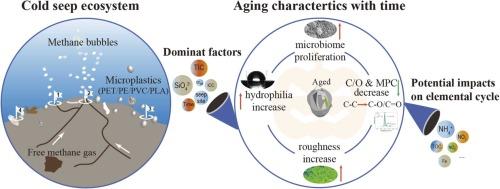当前位置:
X-MOL 学术
›
J. Hazard. Mater.
›
论文详情
Our official English website, www.x-mol.net, welcomes your
feedback! (Note: you will need to create a separate account there.)
Methane seepage leads to a specific microplastic aging process in the simulated cold seep environment
Journal of Hazardous Materials ( IF 12.2 ) Pub Date : 2024-11-19 , DOI: 10.1016/j.jhazmat.2024.136572 Xiao Chen, Xiao-Nan Wu, Jing-Chun Feng, Bin Wang, Can-Rong Li, Yi-Lei Lin, Yong-Ji Huang, Song Zhong, Xiao-Chun Zhang, Jun-Lin Hu, Si Zhang
Journal of Hazardous Materials ( IF 12.2 ) Pub Date : 2024-11-19 , DOI: 10.1016/j.jhazmat.2024.136572 Xiao Chen, Xiao-Nan Wu, Jing-Chun Feng, Bin Wang, Can-Rong Li, Yi-Lei Lin, Yong-Ji Huang, Song Zhong, Xiao-Chun Zhang, Jun-Lin Hu, Si Zhang

|
Marine microplastics pose a significant threat to ecosystems, and deep-sea regions serve as critical sinks for these pollutants. Among these regions, cold seeps harbor relatively high concentrations of microplastics. However, research on the aging of microplastics under low-temperature, dark, methane-abundant, and high-pressure conditions remains limited. Seawater and sediment were collected from various Haima cold seepage sites to simulate seepage environments in 200-mL high-pressure reactors. Four types of microplastics at high concentrations of around (approximately 10%) were cultured and monitored over two months to explore how they aged. The key findings are as follows: (1) Compared to areas of weak seepage, methane seepage accelerated microplastic aging, as evidenced by increased surface roughness, enhanced C-O and (C=O)-O bond formation, increased microbial colonization, and reduced contact angles. (2) Microplastic aging is more pronounced in sediments than in seawater, with biodegradable polylactic acid (PLA) exhibiting the most significant aging characteristics and carbon contribution. (3) Aged microplastics induce greater disturbances in inorganic nutrient levels than in organic matter, impacting nitrogen cycle processes involving nitrate, nitrite, and ammonium. This study results reveal the fundamental aging characteristics of microplastics in extremely deep seas and highlight their potential ecological effects.
中文翻译:

甲烷渗漏导致模拟冷渗环境中特定的微塑料老化过程
海洋微塑料对生态系统构成重大威胁,而深海地区是这些污染物的关键汇。在这些地区中,冷泉中含有相对高浓度的微塑料。然而,关于微塑料在低温、黑暗、甲烷丰富和高压条件下老化的研究仍然有限。从海马的各个冷渗地点收集海水和沉积物,以模拟 200 mL 高压反应器中的渗流环境。在两个月的时间里,对四种浓度约为 (约 10%) 的高浓度微塑料进行培养和监测,以探索它们的老化情况。主要发现如下:(1) 与弱渗流区域相比,甲烷渗流加速了微塑料老化,表面粗糙度增加、C-O 和 (C=O)-O 键形成增强、微生物定植增加和接触角减小。(2) 微塑料老化在沉积物中比在海水中更明显,其中可生物降解的聚乳酸 (PLA) 表现出最显着的老化特性和碳贡献。(3) 老化的微塑料对无机营养水平的干扰比有机物更大,影响涉及硝酸盐、亚硝酸盐和铵态氮的循环过程。这项研究结果揭示了微塑料在极深海中的基本老化特征,并突出了其潜在的生态影响。
更新日期:2024-11-19
中文翻译:

甲烷渗漏导致模拟冷渗环境中特定的微塑料老化过程
海洋微塑料对生态系统构成重大威胁,而深海地区是这些污染物的关键汇。在这些地区中,冷泉中含有相对高浓度的微塑料。然而,关于微塑料在低温、黑暗、甲烷丰富和高压条件下老化的研究仍然有限。从海马的各个冷渗地点收集海水和沉积物,以模拟 200 mL 高压反应器中的渗流环境。在两个月的时间里,对四种浓度约为 (约 10%) 的高浓度微塑料进行培养和监测,以探索它们的老化情况。主要发现如下:(1) 与弱渗流区域相比,甲烷渗流加速了微塑料老化,表面粗糙度增加、C-O 和 (C=O)-O 键形成增强、微生物定植增加和接触角减小。(2) 微塑料老化在沉积物中比在海水中更明显,其中可生物降解的聚乳酸 (PLA) 表现出最显着的老化特性和碳贡献。(3) 老化的微塑料对无机营养水平的干扰比有机物更大,影响涉及硝酸盐、亚硝酸盐和铵态氮的循环过程。这项研究结果揭示了微塑料在极深海中的基本老化特征,并突出了其潜在的生态影响。


















































 京公网安备 11010802027423号
京公网安备 11010802027423号